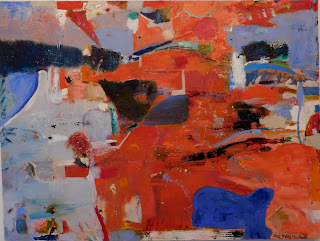Slowed,
but not Silent
By
Tom Wachunas
…So now you come with open hands, mirrors in
your eyes, to lead him from this foreign land, so once again he tries. And each
day’s passing cuts another string, like snow atop the mountain, melting into
Spring. – lyrics
from “Each Day’s Passing,” a song I wrote in 1975
In her 1970
song, “Big Yellow Taxi,” a distressed Joni Mitchell sang, “Don't it always seem
to go that you don't know what you've got 'til it's gone?” Paradise paved
indeed. Thanks to Covid 911, ARTWACH has been quarantined (or imprisoned?) -
sentenced to remain disconnected from our local galleries and museums,
theaters, and concert halls. They’re empty. Lights out, doors shut. OK, not
‘gone’ completely - just on indefinite vacation. Still, in this protracted
viral moment, I’m feeling somewhat bound by the exceptionally taut strings of
sheer anxiety.
So what’s this
critic to do? Of course I’m still making visual art in my studio, albeit rather
slowly. That said, my state of mind has been nevertheless paved with
unsatisfied longing – call it a benevolent obsession – to celebrate and wonder,
or to speculate, or doubt, or reconsider. I greatly miss the actual going to a place, to be in the physical, real-time presence of, to look at, to hear, to think and feel and write about other artists’ works. I miss the connecting, the
solidarity, the fulfilling of a purpose - the sharing of things discovered.
And isn’t that
the function of a critic? But enough about me and my introspection already. Do you find any of the following, randomly
selected musings from various thinkers, writers, and artists useful,
entertaining, or at least mildly interesting? Can we talk here?
Don't
be an art critic. Paint. There lies salvation.
- Paul Cezanne
One
gets tired of the role critics are supposed to have in this culture: it's like
being the piano player in a whorehouse; you don't have any control over the
action going on upstairs. - Robert Hughes
The
aim of all commentary on art now should be to make works of art - and, by
analogy, our own experience - more, rather than less, real to us. The function
of criticism should be to show how it is what it is, even that it is what it
is, rather than to show what it means. - Susan Sontag
Art
criticism, I would say, is about the most ungrateful form of 'elevated' writing
I know of. It may also be one of the most challenging.. if only because so few
people have done it well enough to be remembered.. but I'm not sure the
challenge is worth it. - Clement Greenberg
Art
criticism everywhere is now at a low ebb, intellectually corrupt, swamped in
meaningless jargon, distorted by political correctitudes, anxiously addressed
only to other critics and their ilk. - Brian Sewell
Criticism
talks a good deal of nonsense, but even its nonsense is a useful force. It
keeps the question of art before the world, insists upon its importance. -
Henry James
In
certain kinds of writing, particularly in art criticism and literary criticism,
it is normal to come across long passages which are almost completely lacking
in meaning. – George
Orwell
Modern
art always projects itself into a twilight zone where no values are fixed. It
is always born in anxiety, at least since Cézanne. And Picasso once said that
what matters most to us in Cézanne, more than his pictures, is his anxiety. It
seems to me a function of modern art to transmit this anxiety to the spectator,
so that his encounter with the work is--at least while the work is new-- a
genuine existential predicament. .. the
picture seems arbitrary, cruel, irrational, demanding your faith, while it
makes no promise of future rewards. In other words, it is in the nature of
original contemporary art to present itself as a bad risk. And we the public,
artists included, should be proud of being in this predicament, because nothing
else would seem to us quite true to life; and art, after all, is supposed to be
a mirror of life. –
Leo Steinberg
Good
art-writers break conventions, hold a few sacrosanct, innovate their own. They
measure their limits by instinct, not by rote. Mostly they learn by seeing
miles of art, and reading good literature in bulk. There is no substitute, for
a writer, for possessing a natural ear for language; a rich vocabulary; a flair
for varied sentence structures; an original opinion; some arresting ideas to
share… - Gilda Williams
I
retain, but suspend, my personal taste to deal with the panoply of the art I
see. I have a trick for doing justice to an uncongenial work: “What would I
like about this if I liked it?” I may come around; I may not. Failing that, I
wonder, What must the people who like this be like? ― Peter Schjeldahl
When
art is made new, we are made new with it. We have a sense of solidarity with
our own time, and of psychic energies shared and redoubled, which is just about
the most satisfying thing that life has to offer…This being so, it is a great
exasperation to come face to face with new art and not make anything of it.
Stared down by something that we don't like, don't understand and can't believe
in, we feel personally affronted, as if our identity as reasonably alert and
responsive human beings had been called into question. We ought to be having a
good time, and we aren't. More than that, an important part of life is being
withheld from us; for if any one thing is certain in this world it is that art
is there to help us live, and for no other reason. – John Russell



















